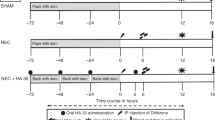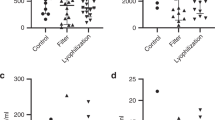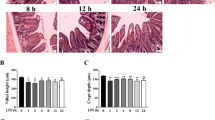Abstract
The purpose of this research was to study the changes in the molecular weight of hyaluronic acid in Wharton's jelly altered by necrotizing funisitis. Umbilical cords were collected at delivery from 20 newborns without funisitis, 6 newborns with acute funisitis, and 4 newborns with necrotizing funistis. Agarose gel electrophoresis of Wharton's jelly was performed to analyze the molecular weight of hyaluronic acid (HA). We also investigated the effects of low or high molecular weight HA on the production of interleukin-8 in human umbilical fibroblasts. In Wharton's jelly without funisitis, HA was 1150 ± 280 kD in preterm newborns, regardless of gestational week at birth, and that in full-term newborns was 1100 ± 200 kD. When acute funisitis was present, HA was 700 ± 250 kD, and when necrotizing funisitis was present, HA was 520 ± kD. The molecular weight of HA was significantly below normal in newborns with necrotizing funisitis. Low molecular weight HA was associated with increased levels of IL-8 in the supernatant of cultured human umbilical fibroblasts in a time- and dose-dependent manner. High molecular weight HA did not induce the production of IL-8 in the same cells. Low molecular weight HA has a potent inflammatory action. The conversion from high to low molecular weight HA in Wharton's jelly may be important in the pathophysiology of necrotizing funisitis.
Similar content being viewed by others
Main
Fetuses with necrotizing funisitis(1–6) are frequently stillborn, and those born alive may be more susceptible to CLD than normal newborns. Ninety percent of the umbilical cord consists of Wharton's jelly, the main component of which is HA(7). HA is an important substance that retains water and maintains the elasticity of the umbilical cord. Recently, low molecular weight HA has been shown to induce chemokine gene expression in various cells(8). We previously reported that low molecular weight HA can induce IL-8 in human cervical tissue(9). Therefore, low molecular weight HA is thought to be a strong inflammatory mediator. We hypothesized that high molecular weight HA in Wharton's jelly is converted to low molecular weight HA as a result of necrotizing funisitis. In this study we determined that low molecular weight HA is increased markedly in newborns with necrotizing funisitis.
MATERIAL AND METHODS
We examined 30 umbilical cords from newborns born at Hamamatsu University School of Medicine from January 1995 to February 1997. The human subjects research committee of our hospital approved this study. Of the 30 cords, 10 were from full-term newborns, 10 were preterm neonates without funisitis, 6 were from preterm neonates with acute funisitis, and 4 were from preterm neonates with necrotizing funisitis. The umbilical cords were collected at the time of delivery and the characteristics of the patients are shown in Table 1.
Birth weight of preterm newborns in the necrotizing funisitis group was less than that in the acute funisitis and no funisitis groups. Two cases of preterm premature rupture of membranes were included in the necrotizing funisitis group. Pregnancy was sustained for more than 1 wk after the premature rupture of membranes in these women by means of tocolysis. The oligohydroamnions due to premature rupture of membranes was thought to be a cause of low birth weight in the necrotizing funisitis group.
The diagnosis of necrotizing funisitis was based on the macroscopic and microscopic deposition of necrotic cell debris in the Wharton's jelly surrounding the umbilical vessels. Necrotic cell debris was characterized by degenerated neutrophils, basophilic debris, and calcification in the form of ring-like or crescentic bands around the umbilical vessels. The diagnosis of acute funisitis was confirmed by the presence of polymorphonuclear leukocytic infiltration into the Wharton's jelly. The standards for high and low molecular weight HA were obtained from Kaken Pharmaceutical Co., Kyoto, Japan. The mean molecular weight of high molecular weight HA was 1100 kD and that of low HA was 500 kD.
Sample preparation and agarose gel electrophoresis. The umbilical cord (1 cm) was obtained at delivery. The Wharton's jelly was carefully separated from the umbilical cord vessels, immersed in 1 mL of PBS, and homogenized for 10 s (IKA Laboratechnik, Staufen, Germany). After centrigugation at 1000 × g for 15 min, the supernatant was collected and stored at -30°C until analysis. To measure the HA component of the jelly, the Wharton's jelly was treated with HA-specific hyaluronidase (hyaluronidase from Streptomyces hyalurolyticus, Seikagaku Co. Tokyo, Japan). Of each sample 20 µL were digested with 1% hyaluronidase from S. hyalurolyticus (2000 THR/mg) in PBS for 4 h at 37°C. The aliquots (20 µL) were subjected to agarose gel (1%) electrophoresis as described previously(10). Different molecular weights of standard HA (Kaken, Kyoto, Japan) were also applied. Each gel was run under 50 V constant voltage for 30 min. The gel was stained with 1% Alcian blue for 30 min; then the gel was destained by five washings with 7% acetic acid and 30% methanol solution. The molecular weight of HA in Wharton's jelly was estimated from the standard HA samples.
Cell culture. The tissue containing Wharton's jelly from full-term infants was cut into small pieces and placed in a 24-well plastic dish. The tissues were cultured in minimal essential medium containing 10% FCS in CO2 at 37°C. When the fibroblasts started to grow rapidly, the tissue was removed from the wells and the culture continued to confluency. The cells were identified as by immunostaining for fibronectin and by observation of their morphology(8). The wells were treated with the different amounts of high molecular weight HA (0.01, 0.1 mg/mL) and low molecular weight HA (0.01, 0.1 mg/mL) and incubated in CO2 at 37°C for 3 to 24 h. The supernatants were then collected, and their IL-8 levels were measured by a commercially available ELISA kit (Amersham, London, UK) involving a quantitative immunometric, sandwich enzyme immunoassay technique. Exact concentrations of IL-8 were calculated from a standard curve according to the manufacturer's directions.
Immunocytochemistry. The human umbilical fibroblasts described above were cultured in minimal essential medium, containing 10% FCS, in a Chamber slide (LAB-TEK, Nalge Nunc International, Naperville, IL). After the cells filled about 70% of the chamber, each well was treated with different amounts of low molecular weight HA (0.01, 0.1 mg/mL) in CO2 for 24 h at 37°C. Then immunocytochemistry was performed. The medium was taken out, and the slides were washed three times with PBS, pH 7.3. The cells were fixed with 3% of paraformaldehyde solution for 10 min at 23°C, and washed again with PBS. The cells were washed twice in PBS (pH 7.5), followed by fixation in methanol and hydrogen peroxide. After washing, sections were blocked with bovine serum albumin (bovine serum albumin-PBS 2%) for 20 min. Polyclonal antibodies to human IL-8 (Oncogen Research Products, Uniodale, NY) were used to treat the sections (dilution 1:60 and 1:40) overnight at 4°C. After five washings in PBS, the sections were incubated with the second antibody (goat anti-rabbit IgG antibody DAKO, Kyoto, Japan) in a concentration of 1:200 for 3 h at room temperature. Avidin (DAKO, Kyoto, Japan) was added in a concentration of 1:1000 and the sections were further incubated for 1 h. Finally, 3% 3-amino-9-ethyl carbazol substrate was added to the sections for 5 min at 23°C (DAKO) and the sections were then counterstained with hematoxylin. Negative control sections were subjected to the same procedures, except that the primary antibodies were replaced with Tris-buffered saline solution.
All data are shown as mean ± SD and t test was used for analysis of the data; p = 0.05 was considered significant.
RESULTS
The bands of the GAGs in Wharton's jelly were observed by Alcian blue staining, and these bands disappeared after hyaluronidase treatment (Fig. 1). Thus, HA was the main GAG in Wharton's jelly, consistent with a previous report(7). The molecular weight of HA from Wharton's jelly without funisitis at 28 wk of gestation was approximately 1000 kD (Fig. 1; Table 2). The molecular weight of HA from the Wharton's jelly with acute funisitis was moderately decreased compared with the nonfunisitis group (Fig. 1) and that from jelly with necrotizing funisitis was significantly lower (p < 0.005) (Figs. 1 and 2). The average molecular weight of HA from a normal cord at preterm was 1150 ± 280 kD, that at full-term was 1100 ± 200 kD, that of acute funisitis 700 ± 250 kD, and that of associated with necrotizing funisitis was 520 ± 100 kD (Table 2). There was a significant difference between cords showing necrotizing funisitis and normal cords.
Agarose gel electrophoresis of Wharton's jelly. Alcian blue staining was performed. Lane 1, 28-wk gestation newborn without necrotizing funisitis; lane 2, 37-wk gestation newborn without necrotizing funisitis; lane 3, 28-wk gestation newborn with necrotizing funisitis; land 4, 32-wk gestation newborn with acute funisitis; lane 5, sample 1 treated with hyaluronidase; lane 6, sample 2 treated with hyaluronidase; lane 7, sample 3 treated with hyaluronidase; lane 8, sample 4 treated with hyaluronidase.
Agarose gel electrophoresis of Wharton's jelly (HA) in four cases of necrotizing funisitis. Lane 1, 30-wk gestation newborn without necrotizing funisitis; lane 2, 27-wk gestation newborn without necrotizing funisitis; lane 3, 26-wk gestation newborn with necrotizing funisitis; land 4, 28-wk gestation newborn with necrotizing funisitis; lane 5, 29-wk gestation newborn with necrotizing funisitis; lane 6, 31-wk gestation newborn with necrotizing funisitis.
Effects of HA on IL-8 production from umbilical fibroblasts. We measured the levels of IL-8 in conditioned media containing umbilical fibroblasts at 0, 3, 6, 12, and 24 h after low molecular weight HA and high molecular weight HA stimulation. IL-8 concentrations in the medium treated with low molecular weight HA increased in a time-dependent manner (Fig. 3a). The IL-8 levels in the medium treated with 0.1 mg/mL low molecular weight HA were significantly higher after 6 h than levels in the controls (p < 0.01), and levels in medium treated with 0.01 mg/mL HA were higher after 12 h than levels in the controls (p < 0.01). In contrast, the IL-8 concentrations of the medium treated with 0.01 or 0.1 mg/mL high molecular weight HA were not significantly higher than those in the controls (Fig. 3b).
A, IL-8 levels in supernatants of human umbilical fibroblasts from low molecular weight HA. White column, no low molecular weight HA; lined column, low molecular weight HA (0.01 mg/mL); hatched column, low molecular HA (0.1 mg/mL). B, IL-8 levels in supernatants of human umbilical fibroblasts from high molecular weight HA. White column, no high molecular weight HA; lined column, high molecular weight HA (0.01 mg/mL); hatched column, high molecular weight HA (0.1 mg/mL). *p < 0.01.
Immunohistochemistry of IL-8. Umbilical fibroblasts of the control samples (no addition of HA) stained weakly for IL-8. A significant increase in the stain density of IL-8 occurred after incubation with 0.1 mg/mL low molecular HA (Fig. 4). The increase was dose dependent (data not shown). The staining density of IL-8 was increased slightly by addition of high molecular HA (Fig. 4).
DISCUSSION
HA is the most abundant GAG component contained in Wharton's jelly(7). It has a tendency to form hydrated gels and therefore contributes significantly to the elastic property of the umbilical cord(11). HA is well recognized as a matrix component and recent studies show that HA also has other functions. HA activates NF-kB/I-kBa which is a transcription factor for IL-8(12). Low molecular weight HA, but not high molecular weight HA, induces chemokine expression via binding to its receptor CD 44(8). We reported that vaginal administration of HA induces cervical ripening by production of IL-8 from human cervical tissue(9). Our study clearly demonstrates that low molecular weight HA is associated with necrotizing funisitis. We also found that low molecular weight HA produces IL-8 from cultured umbilical fibroblasts. IL-8 is a strong neutrophil chemotactic factor that induces an inflammatory reaction in various tissues. High levels of IL-8 in blood and bronchial fluid are seen in infants with CLD(13–14). We have also observed that low molecular weight HA produces TNF-α from cultured umbilical fibroblasts (Kanayama, Goto, Terao, unpublished data). These inflammatory cytokines produced from low molecular weight HA could aggravate the inflammation caused by funisitis. A high incidence of stillbirth, and neonatal morbidity and death have been reported in cases of necrotizing funisitis(5).
There are factors that degrade high molecular weight HA. Superoxides or free radicals cleave high molecular weight HA to low molecular weight HA(15–16), particularly neutrophil radicals in inflammation sites(17). Many radicals are generated from leukocytes in chorioamnionitis(18). These radicals may cause the degradation of high molecular weight HA in the cord. In addition to radicals, hyaluronidase in fetal serum could be another factor causing degradation of high molecular weight HA. The measurement of hyaluronic acid in amniotic fluid may be a useful marker for diagnosing necrotizing funisitis of the fetus in utero. In the future, hyaluronidase inhibitors may be an effective treatment for necrotizing funisitis.
Although the specific expression by low molecular weight HA is unknown, CD44 is known to be a hyaluronan receptor(19–21). The affinity between CD44 and low molecular weight HA may be greater than that between CD44 and high molecular weight HA. In addition, because there are several variant forms of CD44(22), the binding affinity between CD44 and HA could be different in the different variant forms.
We conclude that the presence of low molecular weight HA in the Wharton's jelly during funisitis may be a potent inflammatory mediator.
Abbreviations
- HA:
-
hyaluronic acid
- IL-8:
-
interleukin-8
- CLD:
-
chronic lung disease
- GAG:
-
glycosaminoglycan
- PBS:
-
phosphate-buffered saline
References
Navarro C, Blase JWA 1974 Subacute necrotizing funisitis. J Pediatr 85: 689–697.
Gille J 1977 Granulation tissue in the umbilical cord. J Reprod Med 18: 35–37.
White CA, Longnecker DS 1967 Leukocytic infiltration of the umbilical cord. Obstet Gynecol 29: 711–718.
Craver RD, Baldwin VJ 1992 Necrotizing funisitis. Obstet Gynecol 79: 64–70.
Fujimura M, Takeuchi T, Kitajima H, Nakayama M 1989 Chorioamnionitis and serum IgM in Wilson-Mikity syndrome. Arch Dis Child 64: 1379–1383.
Matsuda T, Nakajima T, Hattori S, Hanatani K, Fukazawa Y, Kobayashi K, Fujimoto S 1997 Necrotizing funisitis: clinical significance and association with chronic lung disease in premature infants. Am J Obstet Gynecol 177: 1402–1407.
Sobolewski K, Bañkowski E, Chyczewski L, Jaworski S 1997 Collagen and glycosaminoglycams of Wharton's jelly. Biol Neonate 71: 11–21.
McKee CM, Penno MB, Cowman M, Burdick MD, Strieter RM, Bao C, Noble PW 1996 Hyaluronan (HA) fragments induce chemokine gene expression in alveolar macrophages. The role of HA size and CD44. J Clin Invest 98: 2403–2413.
Maradny E, Kanayama N, Kobayashi H, Hossain B, Khatun S, Kobayashi T, Terao T 1997 The role of hyaluronic acid as a mediator and regulator of cervical ripening. Hum Reprod 12: 1080–1088.
Lee HG, Cowman MK 1994 An Agarose gel electrophoretic method for analysis of hyaluronan molecular weight distribution. Anal Biochem 219: 278–287.
Takechi K, Kuwabara Y, Mizuno M 1993 Ultrastructural and immunohistochemical studies of Wharton's jelly umbilical cord cells. Placenta 14: 235–245.
Noble PW, McKee CM, Cowman M, Shin H 1996 Hyaluronan fragments activate an NF-kB/I-kBa autoregulatory loop in murine macrophages. J Exp Med 183: 2373–2378.
Kotecha S, Wilson L 1996 Increase in interleukin (IL)-1 beta and IL-6 in bronchoalveolar lavage fluid obtained from infants with chronic lung disease of prematurity. Pediatr Res 40: 250–256.
Groneck P, Speer CP 1995 Inflammatory mediators and bronchopulmonary dysplasia. Arch Dis Child 73:F13.
Weitz Z, Moak SA, Greenwald RA 1988 Degradation of hyaluronic acid by neutrophil derived oxygen radicals is stimulus dependent. J Rheumatol 15: 1250–1253.
Greenwald RA, Moy WW 1980 Effect of oxygen-derived free radials on hyaluronic acid. Arthritis Rheum 23: 455–463.
Greenwald RA, Moak SA 1986 Degradation of hyaluronic acid by polymorphonuclear leukocytes. Inflammation 10: 15–30.
Okada T, Matsuzaki N, Sawai K, Nobunaga T, Shimoya K, Suzuki K, Taniguchi N, Saji F, Murata Y 1997 Chorioamnionitis reduces placental endocrine functions: the role of bacterial lipopolysaccharide and superoxide anion. J Endocrinol 155: 401–410.
Aruffo A, Stamenkovic I, Melnick M, Underhill CB, Seed B 1990 CD44 is the potential cell surface receptor for hyaluronate. Cell 61: 1303–1313.
Culty M, Miyake K, Kincade PW, Silorski E, Butcher EC, Underhill C 1990 The hyaluronate receptor is a member of the CD44 (H-CAM) family of cell surface glycoproteins. J Cell Biol 111: 2765–2774.
Miyake K, Underhill CB, Lesely J, Kincade PW 1990 Hyaluronate can function as a cell adhesion molecule and CD44 participates in hyaluronate recognition. J Exp Med 172: 69–75.
Mackay CR, Terpe HJ, Stauder R, Marston WL, Stark H, Gunthert U 1994 Expression and modulation of CD44 variant isoforms in humans. J Cell Biol 124: 71–82.
Author information
Authors and Affiliations
Additional information
Supported in part by Grants-in-Aid for Specific Research (10671529) from the Japanese Ministry of Education, Science, and Culture, and the Japanese Ministry of Health and Welfare Pediatric Research Grant (98/10-02).
Rights and permissions
About this article
Cite this article
Kanayama, N., Goto, J. & Terao, T. The Role of Low Molecular Weight Hyaluronic Acid Contained in Wharton's Jelly in Necrotizing Funisitis. Pediatr Res 45, 510–514 (1999). https://doi.org/10.1203/00006450-199904010-00009
Received:
Accepted:
Issue Date:
DOI: https://doi.org/10.1203/00006450-199904010-00009







